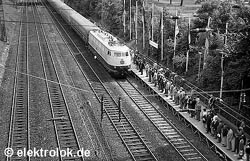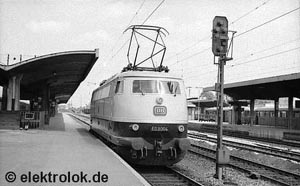| |
E 03
After the war there was of course not anymore something like a highspeed project as carried out by the DRG before the war. The DRG had experimented a lot with highspeed trains with for example the "Fliegender Hamburger" and the E 19 electric locomotive. But after a while when more and more mainlines were electrified in Western Germany and when there were more postwar modern electric locomotives in service there came again new scope for new highspeed projects initiated by the DB.
In the sixties the DB wanted to offer 200 km/h express train services. For these high graded express train services they needed a fast locomotive. In the beginning of the project they thought of a locomotive which was derived of the E 18/E 19 locomotives, but soon the engineers abandoned this idea. Then they decided to develop a locomotive on the basis of the E 10 locomotives. In March 1961, the DB commissioned the German locomotive industry to develop a prototype of a locomotive with a power of 5000 kW and a maximum speed of 200 km/h. The first designs of Henschel were of a six axle locomotive (Co'Co'). The consortium Krupp/AEG designed a locomotive with an axle layout of (1Bo)(Bo1) and a locomotive with an axle layout of (1A1)(1A1), both with non powered axles. Later the DB choosed for a locomotives with six powered axles with an axle layout of (Co'Co').
They decided to built the locomotives by a consortium of Henschel and Siemens. They agreed with each other that there were four prototype locomotive ready at the time of the international traffic exhibition in München in 1965. At the beginning of the developments of this new locomotive they enrolled an extensive testing program with the locomotives E 10 299 and E 10 300. These two class E 10 locomotives were equiped with bogies capable of running at speeds of 200 km/h, they had also changed gears, different panthographs, different axle bearings and a series of other modifications. On the route between Bamberg and Forchheim, the DB made testruns with these two E 10 locomotives. The test results were very positive and so the DB decided to develop the new high speed locomotive class E 03.
In 1965, four prototype locomotives were delivered by Henschel and Siemens. Henschel had built the body parts and Siemens was responsible for the electrical parts of the locomotives. The new six axle locomotives were entering service as E 03 001 through E 03 004. The locomotives were stationed at the Bw München. They were painted in TEE livery. In comparison with the serie locomotives class BR 103.1, the E 03 locomotives had only one row of ventilation grids on both sides of the locomotive body.
 | | The E 03 on the IVA in 1965 | Photo: Kurt Sölch, June 1965, Munich |
The E 03 001 was exhibited in 1965 on the international traffic exhibition in München. The other three locomotives were in service in special trains between München and Augsburg, these trains ran at speeds of 200 km/h. The trains were only for visitors of the exhibition and were also departed from the exhibition grounds. A ride with the train cost DM 4,-. The trip between München and Augsburg lasted only 26 minutes. Most of the trains were pulled by the E 03 004, the E 03 001 was occasionally in service for these special trains. The E 03 002 had some problems with the brakes, so of course this locomotive was not pulling any passenger trains at that time. Lastly the E 03 003 was standing on the exhibition. The E 03 003 had no bogies anymore, they were mounted under the E 03 004 because there were some problems with the bogies of the E 03 004.
From October 1965 the locomotives were not anymore in service in the regular services. The E 03 001, 002 and 004 were only making test and measurement rides. Now and then there was one locomotive seen in the passenger services in a TEE or F-train. In the meantime the E 03 003 was brought back to the AW München Freimann. With testruns between München and Salzburg, they discovered more problems, so the locomotive had to stay longer in the AW. On 15 April 1966 the E 03 003 was again making a ride, but now with more succes.
 | | The E 03 004 with single ventilation grids on both sides | Photo: Kurt Sölch, June 1965, Munich |
After an extensive testprogram it was time to put the locomotives in the regular services. With the summer timetable of 1966, the locomotives had a service of three days. Among the trains they pulled were the TEE 55/56 "Blauer Enzian" between München and Hamburg. The locomotives were also pulling the trains F 33/34 "Gambrinus" between München and Nürnberg and the F 27/28 "Rheinblitz" between München and Stuttgart. The E 10 300 capable of speeds of 200 km/h was a spare locomotive for the E 03 locomotives. The fourth locomotive, the E 03 004 was in service for testruns from the BZA (Bundesbahn Zentralamt) München.
In the winter timetable of 1966/67 the E 03 locomotives made more services, for example in the D-trains (D 551, D 552, D 590) to Nürnberg, and the services in the F-trains to Stuttgart were abandoned due to problems with the locomotives on the Geislinger Steige. The locomotives suffered regularly at boiling cooling liquids caused by the heavy loads on this route.
Because of reparations caused by the repeating occuring problems, the locomotives failed many times. And many times, more than one locomotive failed at the same time. Despite this fact, the Bw München planned four days of service each week for the winter timetable of 1967/68 for the E 03 locomotives. The TEE 54/55 "Blauer Enzian" was the star train which was pulled by an E 03 locomotive. Besides this train, the E 03 locomotives pulled also the TEE 21/22 "Rheinpfeil" between München and Nürnberg, TEE 11/12 "Rembrandt" between München and Stuttgart, F 27/28 "Rheinblitz" between München and Stuttgart and a couple of D-trains.
The locomotives appeared to function very well in the regular services and the results were very positive. In 1967/68 the locomotives had their first 400.000 km inspection. The locomotives got on 1 January 1968 their new numbers and were indicated as class BR 103.0. As the result of the positive tests achieved with the extensive test program, the Deutsche Bundesbahn decided in 1969 to order the serie locomotives of class BR 103.1.
| Axle layout |
Co'Co' |
| In service: |
1965 |
| Diameter driving wheels: |
125 cm |
| Length: |
19,5 m |
| Top speed: |
200 km/h |
| Power: |
6420 kW at 200 km/h |
| Number of motors: |
6 |
| Torque: |
314 kN |
| Tension: |
15 kV ~/16 2/3 Hz |
| Weight: |
110,0 t |
|
